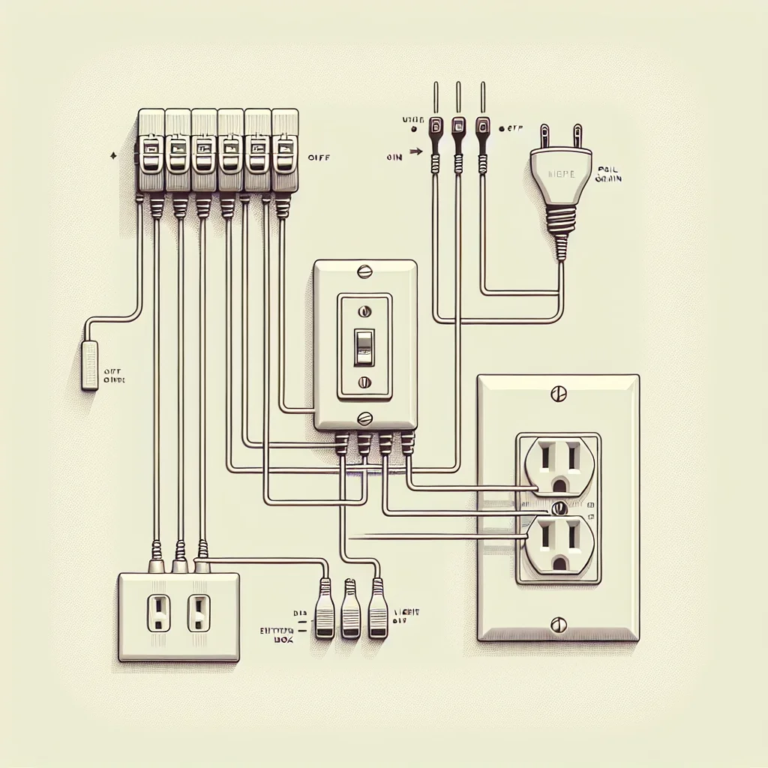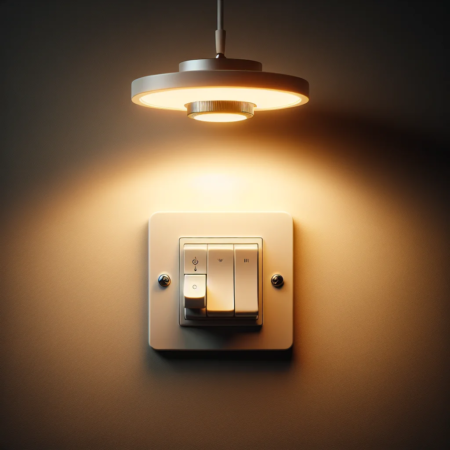Check out this Youtube video: “How many lights can you put on one 15 amp or 20 amp breaker,” for a comprehensive explanation on how to properly install multiple ceiling lights on a single circuit.

Contents
Factors Affecting the Number of Ceiling Lights on One Circuit
The factors affecting the number of ceiling lights on one circuit include the wattage of the lights and the amperage of the circuit. Yes, the wattage of the individual light bulbs directly impacts the total wattage drawn by the circuit, which determines the number of lights that can be safely connected. Yes, understanding the amperage draw of the proposed ceiling lights and aligning it with the circuit’s amperage capacity is essential in determining the number of lights that can be efficiently and safely linked to a single circuit.
Wattage of the lights
The wattage of the lights is a crucial factor to consider when determining the number of ceiling lights that can be connected to a single circuit. Each light fixture has a maximum wattage rating, typically denoted on the fixture itself.
It’s important to adhere to this rating to prevent overloading the circuit and causing potential safety hazards. For instance, if a fixture specifies a maximum of 60 watts, you can opt for any LED bulb with an actual wattage of 60 watts or less.
It’s essential to consider the actual wattage rather than the equivalent wattage for LED bulbs.
To illustrate, let’s consider a scenario where a basic ceiling fixture states “Do not exceed 60 watts.” You can then select LED bulbs with an actual wattage that does not exceed 60 watts to ensure compliance with the fixture’s rating.
In essence, the wattage of the individual light bulbs directly impacts the total wattage drawn by the circuit. By being mindful of the wattage limitations of each fixture, you can effectively gauge the number of lights that can be safely connected to a single circuit without surpassing the wattage threshold.
Amperage of the circuit
Determining the amperage of the circuit is essential for calculating the number of ceiling lights that can be accommodated. To conduct this calculation, ascertain the amperage draw of the light bulbs to be used.
For example, if each bulb has an amperage rating of 0.8 amps, divide the total available amperage by 0.8 to derive the maximum number of light bulbs that can be connected to the circuit safely.
For instance, if the total amperage available is 16 amps, dividing this figure by the amperage draw per bulb (0.8) yields the total number of light bulbs that can be connected without exceeding the circuit’s amperage capacity.
Additionally, understanding the normal voltage and amperage of a light fixture is pivotal for gauging whether the existing wiring and fixtures can support the anticipated current demand of the installation. This knowledge empowers individuals to assess the compatibility of their lighting setup with the electrical infrastructure, ensuring safety and optimal performance.
Comprehending the amperage draw of the proposed ceiling lights and aligning it with the circuit’s amperage capacity plays a pivotal role in determining the number of lights that can be efficiently and safely linked to a single circuit.
Answering the Question: How Many Ceiling Lights on One Circuit?
To determine the maximum number of ceiling lights on one circuit, you need to calculate the total wattage of the fixtures, adhere to the NEC regulations for maximum circuit breaker size, and ensure the amperage is within safe limits. By considering these factors, you can make informed decisions about the appropriate number of ceiling lights on a single circuit. Yes, it is essential to consider wattage, amperage, and safety regulations when determining the maximum number of ceiling lights on one circuit to avoid overloading and safety concerns.
Calculating the maximum number based on wattage and amperage
To calculate the maximum number of ceiling lights on one circuit, we must consider the wattage and amperage. First, determine the total wattage of the fixtures by multiplying the number of lamps by each lamp’s wattage. For instance, if there are 2 lamps with 32 watts each, the total wattage of the fixtures would be 2 x 32 = 64 Watts.
Next, it’s crucial to understand the ampacity of the circuit. The National Electrical Code (NEC) sets a maximum limit for lighting circuit breakers at 50A.
This means that the total wattage of the ceiling lights should not exceed the capacity of the circuit breaker. Remember, it’s always essential to adhere to safety standards and regulations, ensuring the wiring and circuitry can handle the load without causing hazards.
When planning the arrangement of ceiling lights in different rooms of a home or commercial space, calculating the maximum amperage becomes vital. This involves considering the wattage of each room and converting it into amperage.
Likewise, for commercial lighting circuits, the maximum ampacity must be determined to avoid overload and safety concerns.
To determine the maximum number of ceiling lights on one circuit, we need to calculate the total wattage of the fixtures, adhere to the NEC regulations for maximum circuit breaker size, and ensure the amperage is within safe limits. By considering these factors, we can make informed decisions about the appropriate number of ceiling lights on a single circuit.
Ensuring Safety and Efficiency
Avoiding overloading the circuit
Overloaded circuits can pose serious safety hazards in a home or commercial setting. When a circuit carries more electricity than it can handle, it becomes overloaded, leading to potential power disruptions, equipment damage, fire hazards, and shortened lifespans for electrical components.
One common sign of an overloaded circuit is a breaker that keeps tripping, which denotes excessive current flow. Additionally, scorched outlets or outlet covers, flickering or dimming lights, and burning odors can all indicate an overloaded circuit.
It is essential to ensure that the total wattage of all individual light fixtures does not exceed the circuit’s rated capacity.
To avoid overloading a circuit, it’s crucial to distribute the electrical load evenly across different circuits and install additional circuits if needed. It is recommended to limit the number of high-wattage devices or fixtures on a single circuit to prevent overloading.
Regularly assessing the electrical load on circuits and ensuring that it aligns with the circuit’s capacity is integral in preventing overloads and maintaining a safe electrical system.
Consulting with a licensed electrician if unsure
In situations where there is uncertainty about the electrical wiring and capacity, consulting with a licensed electrician is paramount for ensuring safety and compliance with electrical codes and regulations. Licensed electricians have the expertise to evaluate the electrical system’s capacity, identify potential issues, and provide professional recommendations to address concerns.
They can conduct a comprehensive assessment to determine the number of ceiling lights that can be safely installed on a circuit based on the circuit’s load capacity and the wattage of the light fixtures.
An electrician’s guidance can also ensure that the installation adheres to safety standards and local building codes. This includes considering factors such as the type and rating of circuit breakers, wire gauge, and the use of proper electrical connectors.
By seeking professional assistance, individuals can gain peace of mind knowing that the electrical work is carried out in a safe and efficient manner, reducing the risk of overloads and other electrical hazards.
Ensuring safety and efficiency in electrical systems, especially concerning the number of ceiling lights on a single circuit, requires diligence and adherence to electrical guidelines. By being mindful of the signs of circuit overloading and seeking expert advice when needed, individuals can maintain a safe and reliable electrical infrastructure.
Best Practices for Circuit Allocation
When distributing ceiling lights across multiple circuits for balanced load, it is important to consider the maximum wattage that the circuit can handle and the number of fixtures that will be connected to it. Ensuring that the load is balanced helps to prevent overloading the circuit and reduces the risk of electrical hazards. Here are the best practices for circuit allocation when it comes to distributing ceiling lights:
Determining Circuit Capacity and Load Calculation
First, identify the maximum load capacity of the circuit and the total wattage of the ceiling lights that will be connected to it. By dividing the total wattage by the voltage of the circuit (usually 120V in residential settings), you can calculate the current flowing through the circuit. This calculation helps in ensuring that the load is within the safe operating range of the circuit.
Balance and Evenly Distribute the Load
Once the load calculation is complete, aim to evenly distribute the ceiling lights across multiple circuits to avoid placing a heavy load on one circuit while leaving others underutilized. This helps in promoting balanced power distribution and prevents the risk of overloads and flickering lights.
Consider Using LED Lighting
Incorporating energy-efficient LED lighting can significantly reduce the overall wattage of the ceiling lights, allowing for a greater number of fixtures to be connected to a single circuit while still maintaining a balanced load. LED lighting also contributes to energy conservation and cost savings in the long run.
Installation of Dimmer Switches
Utilizing dimmer switches for ceiling lights provides the flexibility to adjust the intensity of the lighting. This not only enhances ambiance but also helps in regulating the power consumption. By allowing adjustable illumination levels, it becomes easier to maintain a balanced load across circuits.
Labeling and Documentation
Properly labeling the electrical panel and maintaining accurate documentation of the circuit allocation and the connected fixtures is crucial. This helps in future reference, troubleshooting, and ensures that the electrical system is organized and well-documented.
Regular Inspections and Maintenance
Lastly, conduct regular inspections and maintenance of the electrical system to ensure that the load is still balanced and that the circuits are functioning optimally. Any additions or modifications to the lighting fixtures should be carefully considered to maintain a balanced load across circuits.
When distributing ceiling lights across multiple circuits, it is essential to calculate the load, evenly distribute the fixtures, consider energy-efficient options, use dimmer switches, maintain documentation, and prioritize regular inspections. By adhering to these best practices, it becomes possible to achieve a well-balanced circuit allocation for ceiling lights, promoting safety and efficiency within the electrical system.





